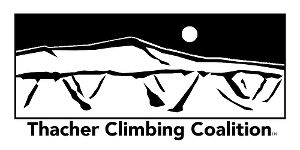
Getting a new climbing area started is a large task and has required over 30 volunteers and 1000s of volunteer hours so far. In the beginning it seemed like we could get a public opening day within a little over a year, however 4 years later we are just now finally getting close to ready. The good part about this gradual ramp-up has been we’ve been ability to include many community members in the policy and infrastructure work, so people have had a chance to help guide progress and give valuable input prior to “going live”. If you are not currently volunteering and you’d like to help out please contact us.
UPDATE July 2017: Climbing is now legal.
Below are a few key dates and milestones over the last 4 years.
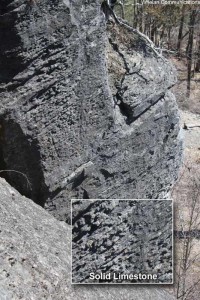
1974 – Current – Off-trail travel is prohibited in the cliff areas, this includes a ban on ice and rock climbing. The lack of a vertical rescue team and corruption of tort law in the state were the initial reason for the restricted access, however by the 2000s a skilled vertical rescue team already operates, and the off-trail travel rules simply prevents skilled and careful climbers from getting access while failing to prevent irresponsible “unskilled” tourists from breaking the law and creating incidents.
3/14/2012 – The TCC unofficially starts with a recon photo day at Thacher where after inspection of the rock and topography it is decided to proceed with pursuing climbing, modeled after a limestone sport area on BLM land called Shelf Road in Colorado.
March 2012 – TCC Founder M. Whelan connects with the Access Fund and co-founder G. Miani to get started with notes and social media. At the first meeting with New York State Parks we demonstrate how the basics of how sport climbing works to administrators and managers, and a vision of how climbing would look implemented in the park.
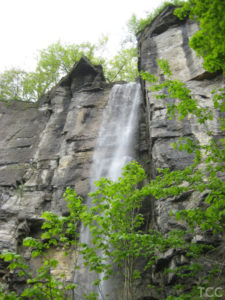
April-May 2012 – About 20 area climbers show up at a public meeting hosted by the park to voice their support in numbers. The TCC contacts the Nature Conservancy about working on cliff area land conservation close to the park. G. Miani conducts a site survey with park officials and researches property issues.
Summer – Fall 2012:
The TCC holds its first public meetings in Clifton Park and New Paltz. On-site photographic surveys look at viability of climbing section by section at the park. Two park staff test climb a section of the Upper Misery Wall at Thacher. A local board of the TCC is formed with 7 members. An official Master Report on rock climbing is written for the park and covers all issues A-Z about climbing and management at the park.
2013:
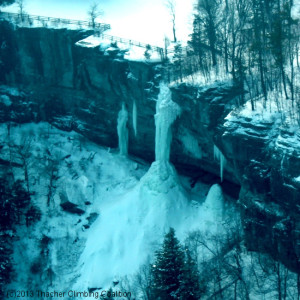
Winter 2013: A winter aerial and ground survey is done to look at the ice potential in the park at peak ice season in February after 5 cold weeks. The TCC hosts its first fundraiser at the Edge Halfmoon. Bylaws are enacted for the organization.
Summer 2013: The official “Ice Report” is completed and submitted to the state. NYS continues its work on the new Master Plan for Thacher park. The TCC works with them on the climbing section. There are more public meetings which climbers attend. Route development and other climber volunteer work is still not permitted, only photographic surveys.
2014:
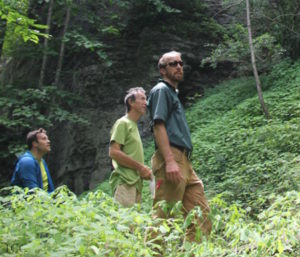
Summer 2014: The park permits regional climbing experts (30+ years development experience) to look at the rock with park officials and determine potential for the area. No climbing is allowed for the surveys. The TCC launches its website.
Fall 2014: The park finally allows route development, however requires certain paperwork to be done and this delays progress too late into the season, and the winter weather arrives.
2015:
Spring – Summer 2015: The TCC conducts informational surveys with the constituency meanwhile the park continues to iron out issues with policy. By August the park gives the real go ahead to develop routes as all paperwork is approved.
 Fall 2015: P. Thompson – a developer with history at Shelf Road, CO comes and works with the TCC board to start 13 routes.
Fall 2015: P. Thompson – a developer with history at Shelf Road, CO comes and works with the TCC board to start 13 routes.
The first sport climbing route at Thacher, a 5.8 crack at the Mahican Section is completed on 9/24/2015 (1258 days after the TCC began).
In a second visit more local volunteers are added as 37 projects are started. Regional developers with significant experience (from the Adirondacks and Rumney) are invited to come and develop at the cliff. A rough path is cut between the two major cliff areas, this reduces travel time from a 1 hour bushwhack to 15 minute hike. Still much trail work will be needed in the future. A critical mass of routes must also be developed prior to a public opening.
2016:
Spring 2016: TCC internal functions are streamlined as we wait for warm weather and paperwork to process. J. Moss becomes president of the organization and leads the effort to bring the organization up from a State nonprofit status to federal 501c3 status. TCC’s work is highlighted at the Access Fund’s Future of Fixed Anchors II Conference.
Summer 2016: Development starts in June and continues through the summer on routes. Determining route locations is a first important step before trail improvements can be made. The TCC continues to bring in new volunteers, some of which bring development experience from other areas like the Adirondacks.
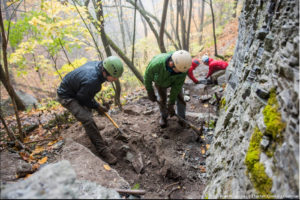
Fall 2016: Development of routes continues into the fall. Several trail days jointly hosted by the TCC and Access Fund are held to improve the primary access trail. The first public member meeting is held on September 20th. A new board leads the TCC. Another Reel Rock fundraiser is held. The year concludes with a greatly expanded volunteer base and infrastructure close to ready for the public.
If you would like to volunteer for the spring please contact us.
Please mention if you have history with trail or route development. Volunteers with all levels of experience in infrastructure work are welcome.
Climbing is now legal:
VISIT THACHER
